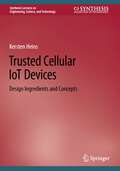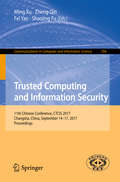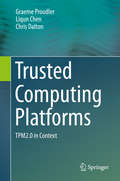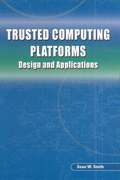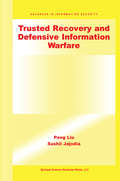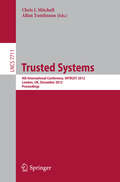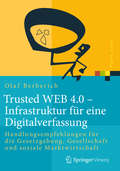- Table View
- List View
Trusted Cellular IoT Devices: Design Ingredients and Concepts (Synthesis Lectures on Engineering, Science, and Technology)
by Kersten HeinsThis book focuses on the impact of secure frontend devices for the Internet of Things (IoT). It explains how to identify vulnerabilities of IoT applications and how to protect them against misuse and attacks. Provided insights will help readers to design a reliable and trustworthy IoT ecosystem ensuring a high level of user confidence and a fruitful deployment. As a starting point, the book provides guidance how to identify risks and potential threats. Then, it explains which countermeasures are available and introduces all major ingredients for an efficient implementation of IoT security measures, e.g. a bullet-proof protection of user privacy and device identities. The author outlines an efficient design approach that combines classical embedded computing with smartcard technology and wireless cellular networking like LTE-M or NB-IoT. The target audience includes industrial professionals and students focusing on low cost design and a fast time-to-market. The book is ideal for engineering-minded IoT project owners to safeguard their business goals.
Trusted Cloud Computing
by Helmut Krcmar Ralf Reussner Bernhard RumpeThis book documents the scientific results of the projects related to the Trusted Cloud Program, covering fundamental aspects of trust, security, and quality of service for cloud-based services and applications. These results aim to allow trustworthy IT applications in the cloud by providing a reliable and secure technical and legal framework. In this domain, business models, legislative circumstances, technical possibilities, and realizable security are closely interwoven and thus are addressed jointly.The book is organized in four parts on “Security and Privacy”, “Software Engineering and Software Quality”, “Platforms, Middleware and Integration”, and “Social Aspects, Business Models and Standards”. It thus provides a holistic view on technological, societal, and legal aspects, which are indispensable not only to ensure the security of cloud services and the data they process, but also to gain the trust of society, business, industry, and science in these services.The ultimate goal of the book, as well as of the Trusted Cloud Program in general, is to distribute these results to a broader audience in both academia and industry, and thus to help with the proliferation of "Industry 4.0" services.
Trusted Computing: Second International Conference, Trust 2009 Oxford, UK, April 6-8, 2009, Proceedings (Lecture Notes in Computer Science #5471)
by Liqun Chen Chris J. Mitchell Andrew MartinThisvolumecontainsthe15paperspresentedinthetechnicalstrandoftheTrust 2009 conference, held in Oxford, UK in April 2009. Trust 2009 was the second international conference devoted to the technical and socio-economic aspects of trusted computing. The conference had two main strands, one devoted to technical aspects of trusted computing (addressed by these proceedings), and the other devoted to socio-economic aspects. Trust 2009 built on the successful Trust 2008 conference, held in Villach, Austria in March 2008. The proceedings of Trust 2008, containing 14 papers, were published in volume 4968 of the Lecture Notes in Computer Science series. ThetechnicalstrandofTrust2009contained15originalpapersonthedesign and application of trusted computing. For these proceedings the papers have been divided into four main categories, namely: – Implementation of trusted computing – Attestation – PKI for trusted computing – Applications of trusted computing The 15 papers included here were selected from a total of 33 submissions. The refereeing process was rigorous, involving at least three (and mostly more) independent reports being prepared for each submission. We are very grateful to our hard-working and distinguished Program Committee for doing such an excellent job in a timely fashion. We believe that the result is a high-quality set of papers, some of which have been signi?cantly improved as a result of the refereeing process. We would also like to thank all the authors who submitted their papers to the technical strand of the Trust 2009 conference, all external referees, and all the attendees of the conference.
Trusted Computing: Ein Weg zu neuen IT-Sicherheitsarchitekturen
by Norbert Pohlmann Helmut ReimerTrusted Computing markiert einen grundsätzlichen Wandel der IT-Sicherheitsarchitekturen. Erstmals werden die Potenziale von sicherer integrierten Hard- und Software verfügbar. Seit 1999 sind die wesentlichen Konzepte, Standards, Baugruppen und Softwaremodule entwickelt und zur Anwendungsreife gebracht worden. Das Buch fasst die vorliegenden Grundlagen zusammen. Es behandelt erstmals wichtige Anwendungsszenarien mit signifikantem Sicherheitsgewinn für IT-Systembetreiber und -anwender. Besonders berücksichtigt wird dabei Open Source Software als Beitrag zur Vertrauenswürdigkeit der Lösungen. Es wird gezeigt, dass Trusted Computing die traditionellen chipkartenbasierten Konzepte der IT-Sicherheit wirkungsvoll ergänzt und dass Datenschutz und andere rechtliche Vorgaben erfüllt werden.
Trusted Computing and Information Security: 13th Chinese Conference, CTCIS 2019, Shanghai, China, October 24–27, 2019, Revised Selected Papers (Communications in Computer and Information Science #1149)
by Weili Han Liehuang Zhu Fei YanThis book constitutes the refereed proceedings of the Chinese Conference on Trusted Computing and Information Security, CTCIS 2019, held in Shanghai, China, in October 2019.The 22 revised full papers presented were carefully reviewed and selected from 247 submissions. The papers are centered around cryptography, systems security, trusted computing, information security, network security, information hiding.
Trusted Computing and Information Security: 11th Chinese Conference, CTCIS 2017, Changsha, China, September 14-17, 2017, Proceedings (Communications in Computer and Information Science #704)
by Ming Xu Zheng Qin Fei Yan Shaojing FuThis book constitutes the refereed proceedings of the 11th Chinese Conference on Trusted Computing and Information Security, CTCIS 2017, held in Changsha, China, in September 2017. The 28 revised full papers presented were carefully reviewed and selected from 96 submissions. The papers focus on topics such as theory of trusted computing, trustworthy software; infrastructure of trusted computing, application and evaluation of trusted computing; network security and communication security; theory and technology of cryptographic techniques; information content security; system security for mobile network and IoT systems, industrial control and embedded systems; security for Cloud computing, virtualization systems and big data.
Trusted Computing and Information Security: 12th Chinese Conference, CTCIS 2018, Wuhan, China, October 18, 2018, Revised Selected Papers (Communications in Computer and Information Science #960)
by Huanguo Zhang Bo Zhao Fei YanThis book constitutes the refereed proceedings of the Chinese Conference on Trusted Computing and Information Security, CTCIS 2018, held in Wuhan, China, in October 2018.The 24 revised full papers presented were carefully reviewed and selected from 73 submissions. The papers are centered around cryptography, systems security, trusted computing, information security, and network security.
Trusted Computing - Challenges and Applications: First International Conference on Trusted Computing and Trust in Information Technologies, TRUST 2008 Villach, Austria, March 11-12, 2008 Proceedings (Lecture Notes in Computer Science #4968)
by Peter Lipp Ahmad-Reza Sadeghi Klaus-Michael KochThis volume contains papers presented at TRUST 2008, the ?rst international conference on Trusted Computing and Trust in Information Technologies, held in March 2008 in Villach, Austria. The aim of the conference was to create a joint scienti?c and networking platform covering the core issues of trust in IT systems and trusted computing and to bridge the gaps between international research groups and projects in closely related ?elds. The organizers received 43 submissions from 17 countries. Each of the s- mittedpaperswasreviewedbythreereviewers.Basedonthesereviews13papers were selected as suitable for the conference and the authors were asked to p- sent their work. Further, six renowned speakers from academia, industry and the European Commission were invited for keynotes. The accepted papers are published in this volume together with one paper from Paul England, one of the invited speakers at TRUST 2008. TheconferencewassupportedbytheEuropeanCommissionviatheOpen-TC project (FP6 IST-027635), by the Austrian Research Promotion Agency (FFG) and by the city of Villach.
Trusted Computing for Embedded Systems
by Bernard Candaele Dimitrios Soudris Iraklis AnagnostopoulosThis book describes the state-of-the-art in trusted computing for embedded systems. It shows how a variety of security and trusted computing problems are addressed currently and what solutions are expected to emerge in the coming years. The discussion focuses on attacks aimed at hardware and software for embedded systems, and the authors describe specific solutions to create security features. Case studies are used to present new techniques designed as industrial security solutions. Coverage includes development of tamper resistant hardware and firmware mechanisms for lightweight embedded devices, as well as those serving as security anchors for embedded platforms required by applications such as smart power grids, smart networked and home appliances, environmental and infrastructure sensor networks, etc.· Enables readers to address a variety of security threats to embedded hardware and software;· Describes design of secure wireless sensor networks, to address secure authentication of trusted portable devices for embedded systems;· Presents secure solutions for the design of smart-grid applications and their deployment in large-scale networked and systems.
Trusted Computing Platforms: TPM2.0 in Context
by Graeme Proudler Liqun Chen Chris DaltonIn this book the authors first describe the background of trusted platforms and trusted computing and speculate about the future. They then describe the technical features and architectures of trusted platforms from several different perspectives, finally explaining second-generation TPMs, including a technical description intended to supplement the Trusted Computing Group's TPM2 specifications. The intended audience is IT managers and engineers and graduate students in information security.
Trusted Computing Platforms: Design and Applications
by Sean W. SmithFrom early prototypes and proposed applications, this book surveys the longer history of amplifying small amounts of hardware security into broader system security Including real case study experience with security architecture and applications on multiple types of platforms. Examines the theory, design, implementation of the IBM 4758 secure coprocessor platform and discusses real case study applications that exploit the unique capabilities of this platform. Examines more recent cutting-edge experimental work in this area. Written for security architects, application designers, and the general computer scientist interested in the evolution and use of this emerging technology.
Trusted Computing Systeme: Konzepte und Anforderungen (Xpert.press)
by Thomas MüllerDer Begriff Trusted Computing umschreibt neue Ansätze zur Verbesserung der Computersicherheit durch vertrauenswürdige Hardware- und Softwarekomponenten. Das Buch liefert erstmals einen umfassenden Überblick über verschiedene Konzepte des Trusted Computing. Über die Beschreibung der Trusted Platform Modules (TPM) hinaus werden Schutzfunktionen zukünftiger Hardwarekomponenten (Intel, AMD) erläutert. Eine Untersuchung der neuen Sicherheitsfunktionen in Windows Vista zeigt den Einfluss von Trusted Computing auf die Entwicklung von Betriebssystemen.
Trusted Digital Circuits: Hardware Trojan Vulnerabilities, Prevention and Detection
by Hassan SalmaniThis book describes the integrated circuit supply chain flow and discusses security issues across the flow, which can undermine the trustworthiness of final design. The author discusses and analyzes the complexity of the flow, along with vulnerabilities of digital circuits to malicious modifications (i.e. hardware Trojans) at the register-transfer level, gate level and layout level. Various metrics are discussed to quantify circuit vulnerabilities to hardware Trojans at different levels. Readers are introduced to design techniques for preventing hardware Trojan insertion and to facilitate hardware Trojan detection. Trusted testing is also discussed, enabling design trustworthiness at different steps of the integrated circuit design flow. Coverage also includes hardware Trojans in mixed-signal circuits.
Trusted Execution Environments
by Konstantinos Markantonakis Carlton ShepherdTrusted execution environments (TEEs) protect sensitive code and data on computing platforms, even when the primary operating system is compromised. Once a technical curiosity, TEEs have rapidly become a key component in securing numerous systems from cloud servers to constrained devices. Today, TEEs have been deployed on billions of devices for protecting financial payments, personal files, copyrighted media content, and many others. Despite this, TEEs remain poorly understood due to their complexity and diversity. This book addresses this gap, providing a comprehensive treatment of different TEE technologies, their features, benefits, and shortcomings.A holistic view of secure and trusted execution is taken, examining smart cards and CPU protection rings before discussing modern TEEs, such as Intel SGX and ARM TrustZone. A wide range of paradigms for building secure and trusted execution environments are explored, from dedicated security chips to system-on-chip extensions and virtualisation technologies. The relevant industry standards and specifications are covered in detail, including how TEEs are evaluated and certified in practice with respect to security. Several case studies are presented showing how TEEs are used in some common security mechanisms, such as secure boot sequences, biometric authentication, and file-based encryption. This book also discusses present challenges in the field, covering potential attack vectors against TEEs and concerns relating to fragmentation, interoperability, and transparency. Lastly, a selection of future directions are examined that may be used by the trusted execution environments of tomorrow.This book is particularly targeted at practitioners and researchers in cyber security, such as penetration testers, security engineers, and security analysts. Additionally, this book serves as a valuable resource for university students, both postgraduate and advanced undergraduates, and professors in computer science and electrical engineering.
Trusted Information: The New Decade Challenge (IFIP Advances in Information and Communication Technology #65)
by Michel Dupuy Pierre ParadinasSince the early eighties IFIP/Sec has been an important rendezvous for Information Technology researchers and specialists involved in all aspects of IT security. The explosive growth of the Web is now faced with the formidable challenge of providing trusted information. IFIP/Sec’01 is the first of this decade (and century) and it will be devoted to “Trusted Information - the New Decade Challenge” This proceedings are divided in eleven parts related to the conference program. Session are dedicated to technologies: Security Protocols, Smart Card, Network Security and Intrusion Detection, Trusted Platforms. Others sessions are devoted to application like eSociety, TTP Management and PKI, Secure Workflow Environment, Secure Group Communications, and on the deployment of applications: Risk Management, Security Policies andTrusted System Design and Management. The year 2001 is a double anniversary. First, fifteen years ago, the first IFIP/Sec was held in France (IFIP/Sec’86, Monte-Carlo) and 2001 is also the anniversary of smart card technology. Smart cards emerged some twenty years ago as an innovation and have now become pervasive information devices used for highly distributed secure applications. These cards let millions of people carry a highly secure device that can represent them on a variety of networks. To conclude, we hope that the rich “menu” of conference papers for this IFIP/Sec conference will provide valuable insights and encourage specialists to pursue their work in trusted information.
Trusted Recovery and Defensive Information Warfare (Advances in Information Security #4)
by Peng Liu Sushil JajodiaInformation security concerns the confidentiality, integrity, and availability of information processed by a computer system. With an emphasis on prevention, traditional information security research has focused little on the ability to survive successful attacks, which can seriously impair the integrity and availability of a system. Trusted Recovery And Defensive Information Warfare uses database trusted recovery, as an example, to illustrate the principles of trusted recovery in defensive information warfare. Traditional database recovery mechanisms do not address trusted recovery, except for complete rollbacks, which undo the work of benign transactions as well as malicious ones, and compensating transactions, whose utility depends on application semantics. Database trusted recovery faces a set of unique challenges. In particular, trusted database recovery is complicated mainly by (a) the presence of benign transactions that depend, directly or indirectly on malicious transactions; and (b) the requirement by many mission-critical database applications that trusted recovery should be done on-the-fly without blocking the execution of new user transactions. Trusted Recovery And Defensive Information Warfare proposes a new model and a set of innovative algorithms for database trusted recovery. Both read-write dependency based and semantics based trusted recovery algorithms are proposed. Both static and dynamic database trusted recovery algorithms are proposed. These algorithms can typically save a lot of work by innocent users and can satisfy a variety of attack recovery requirements of real world database applications. Trusted Recovery And Defensive Information Warfare is suitable as a secondary text for a graduate level course in computer science, and as a reference for researchers and practitioners in information security.
Trusted Systems: 5th International Conference, INTRUST 2013, Graz, Austria, December 4-5, 2013, Proceedings (Lecture Notes in Computer Science #8292)
by Roderick Bloem Peter LippThis book constitutes the thoroughly refereed conference proceedings of the 5th International Conference on Trusted Systems, INTRUST 2013, held in Graz, Austria, in December 2013. The revised full papers focus on the theory, technologies and applications of trusted systems. They cover all aspects of trusted computing systems, including trusted modules, platforms, networks, services and applications, from their fundamental features and functionalities to design principles, architecture and implementation technologies.
Trusted Systems: First International Conference, INTRUST 2009, Beijing, China, December 17-19, 2009. Proceedings (Lecture Notes in Computer Science #6163)
by Liqun Chen Moti YungThis volume contains the 16 papers presented at the INTRUST 2009 conf- ence, held in Beijing, China in December 2009. INTRUST 2009 was the ?rst international conference on the theory, technologies and applications of trusted systems. It was devoted to all aspects of trusted computing systems, incl- ing trusted modules, platforms, networks, services and applications, from their fundamental features and functionalities to design principles, architecture and implementation technologies. The goal of the conference was to bring academic and industrial researchers, designers and implementers together with end-users of trusted systems, in order to foster the exchange of ideas in this challenging and fruitful area. The program consisted of 3 invited talks and 20 contributed papers. The - vited speakerswere Wenchang Shi (Renmin Universityof China), DavidWooten (Microsoft) and Scott Rotondo (Sun Microsystems). The ?rst speaker provided a paper, which is included in these proceedings. Special thanks are due to these speakers. The contributed talks were arranged with two main tracks, one devoted to academic aspects of trusted computing systems (addressed by these proce- ings), and the other devoted to industrial aspects. The contributed papers were selected out of 42 submissions from 13 countries. The refereeing process was rigorous, involving at least three (and mostly more) independent reports being prepared for each submission. We are very grateful to our hard-working and distinguished Program Committee for doing such an excellent job in a timely fashion.
Trusted Systems: Second International Conference, INTRUST 2010, Beijing, China, December 13-15, 2010, Revised Selected Papers (Lecture Notes in Computer Science #6802)
by Liqun Chen Moti YungThis book constitutes the proceedings of the International Conference on Trusted Systems, held in Beijing, China, in December 2010.The 23 contributed papers presented together with nine invited talks from a workshop, titled "Asian Lounge on Trust, Security and Privacy" were carefully selected from 66 submissions. The papers are organized in seven topical sections on implentation technology, security analysis, cryptographic aspects, mobile trusted systems, hardware security, attestation, and software protection.
Trusted Systems: Third International Conference, INTRUST 2011, Beijing, China, November 27-20, 2011, Revised Selected Papers (Lecture Notes in Computer Science #7222)
by Liqun Chen Moti Yung Liehuang ZhuThis book constitutes the thoroughly refereed post-conference proceedings of the International Conference on Trusted Systems, INTRUST 2011, held in Beijing, China, in November 2011. The 21 revised full papers were carefully reviewed and selected from 34 submissions for inclusion in the book. Except these contributed papers the program of INTRUST also consisted of a workshop titled Asian Lounge on Trust, Security and Privacy consisting of six keynote speeches. The papers are organized in topical sections on trusted services, mobile trusted systems, security analysis, cryptographic aspects, trusted networks, implementation, and direct anonymous attestation.
Trusted Systems: 4th International Conference, INTRUST 2012, London, UK, December 17-18, 2012, Proceedings (Lecture Notes in Computer Science #7711)
by Chris J. Mitchell Allan TomlinsonThis book constitutes the refereed proceedings of the International Conference on Trusted Systems, INTRUST 2012, held in London, UK, in December 2012. The 6 revised full papers presented together with 3 short invited papers and a short paper which formed the basis for a panel session were carefully reviewed and selected from 19 submissions. The papers are organized in topical section on automated analysis, security and trust, mobile trust, security of distributed systems, evaluation and analysis, and embedded security.
Trusted Systems: 7th International Conference, INTRUST 2015, Beijing, China, December 7-8, 2015, Revised Selected Papers (Lecture Notes in Computer Science #9565)
by Moti Yung Jianbiao Zhang Zhen YangThis book constitutes the thoroughly refereed post-conference proceedings of the 7th International Conference on Trusted Systems, INTRUST 2015, held in Beijing, China, in December 2015. The revised 12 full papers presented have been carefully reviewed and selected from 29 submissions. They are devoted to all aspects of trusted computing systems, including trusted modules, platforms; networks, services and applications. The papers are organized in the following sections: encryptions and signatures; security model; trusted technologies; software and system security.
Trusted Systems: 6th International Conference, INTRUST 2014, Beijing, China, December 16-17, 2014, Revised Selected Papers (Lecture Notes in Computer Science #9473)
by Moti Yung Liehuang Zhu Yanjiang YangNormal 0 false false false EN-US X-NONE X-NONE This book constitutes the thoroughly refereed post-conference proceedings of the 6th International Conference on Trusted Systems, INTRUST 2014, held in Beijing, China, in December 2014. The conference brings together academic and industrial researchers, designers, and implementers with end-users of trusted systems, in order to foster the exchange of ideas in this challenging and fruitful area. The revised full papers focus on the theory, technologies and applications of trusted systems and cover all aspects of trusted computing systems, including trusted modules, platforms, networks, services and applications, from their fundamental features and functionalities to design principles, architecture and implementation technologies. /* Style Definitions */ table.MsoNormalTable {mso-style-name:"Table Normal"; mso-tstyle-rowband-size:0; mso-tstyle-colband-size:0; mso-style-noshow:yes; mso-style-priority:99; mso-style-qformat:yes; mso-style-parent:""; mso-padding-alt:0in 5.4pt 0in 5.4pt; mso-para-margin:0in; mso-para-margin-bottom:.0001pt; mso-pagination:widow-orphan; font-size:11.0pt; font-family:"Calibri","sans-serif"; mso-ascii-font-family:Calibri; mso-ascii-theme-font:minor-latin; mso-fareast-font-family:"Times New Roman"; mso-fareast-theme-font:minor-fareast; mso-hansi-font-family:Calibri; mso-hansi-theme-font:minor-latin; mso-bidi-font-family:"Times New Roman"; mso-bidi-theme-font:minor-bidi;}
Trusted WEB 4.0 – Infrastruktur für eine Digitalverfassung: Handlungsempfehlungen für die Gesetzgebung, Gesellschaft und soziale Marktwirtschaft (Xpert.press)
by Olaf BerberichDie totalitären Tendenzen des Internets sind unübersehbar. Wir steuern auf den gläsernen Menschen ohne Freiheitsrechte zu. Geschäftskonzepte weniger Global Player schalten Milliarden Menschen gleich. Die langfristigen Auswirkungen auf die Gesellschaft werden nicht bedacht. Der Autor zeigt konkret, wie die Demokratie nachhaltig in die digitale Gesellschaft übernommen werden kann. Die zukünftige Beherrschung der Menschen durch totalitäre globale Systeme und künstliche Intelligenzen wird ausgeschlossen.Alle Bürger und die regionale Wirtschaft werden in die digitale Wertschöpfungskette fair und leistungsangepasst eingebunden.
